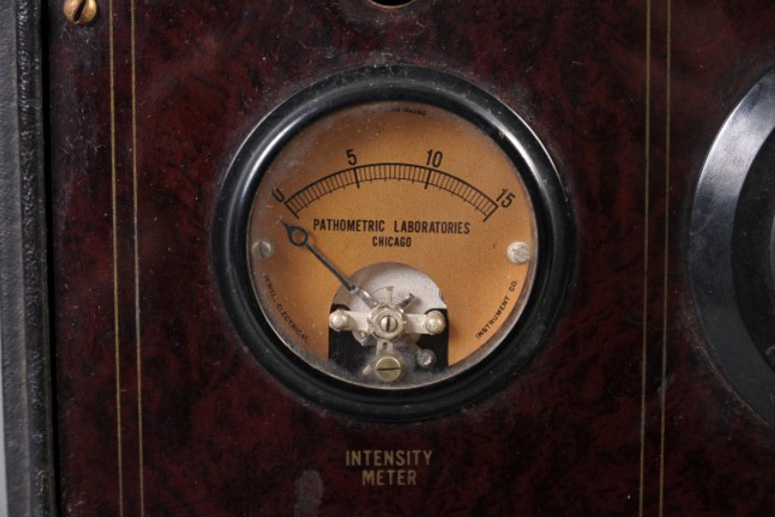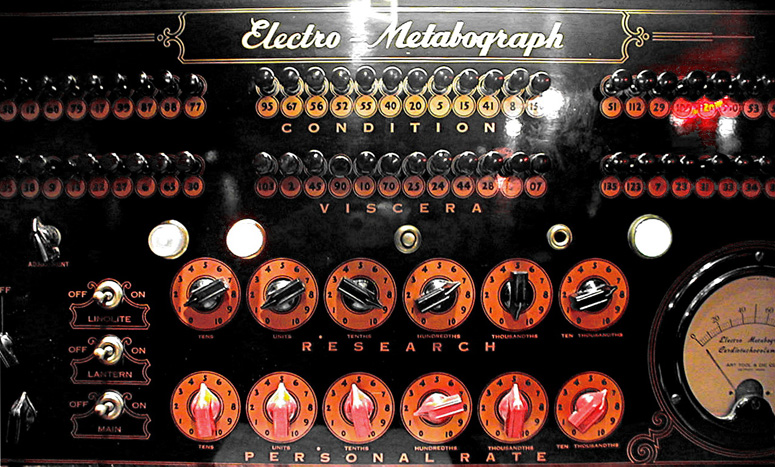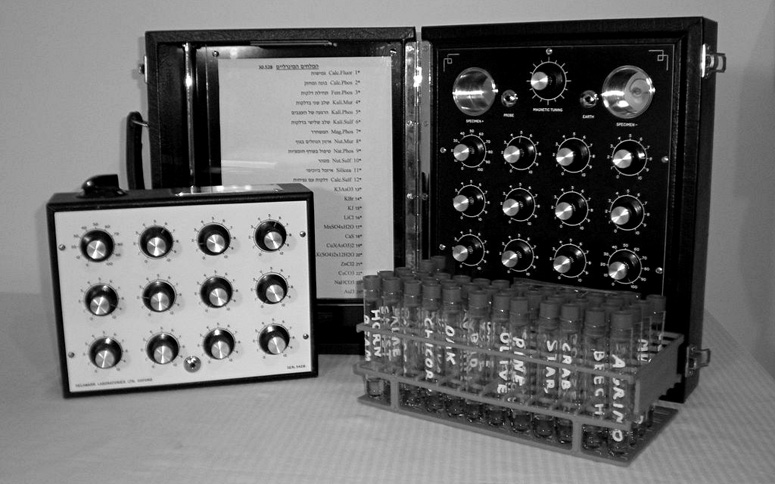Radionics ~ Part III
 by The Radionist (Journal Of Borderland Research)
by The Radionist (Journal Of Borderland Research)
Around 1926, Dr. Wigelsworth and his company, the Pathometric Corporation, produced the Pathoclast, of which a number of models were manufactured during ensuing years. It differed from previous equipment in two significant respects — the use of variable condensors for tuning, and the inclusion of vacuum tubes for amplification.
Tuning was accomplished by means of a large dial for each variable condenser, the dials were calibrated 0 to 100 in 1 or 2 degree divisions. There were two dials per tuning row, and two or three rows, depending upon the model. On a 2 row instrument, the upper row could be used for condition tuning rates and the lower row for visceral (organ) tuning rates. A tuning rate encompassed settings of both left and right hand dials; with each dial capable of being set at any of 100 positions, the total possible number of tuning rates per row therefore was 100 x 100 or a total of 10000; while this may seem to be quite a large number, yet it falls far short of the million-plus combinations possible with a tuning row on the Calbro Magnowave, which incorporated 6 dials each of which could be set anywhere from zero to 10 in unit steps. Many tuning rates used on the Calbro Magnowave and successor instruments had no representation on the Pathoclast so could not be used on it or on any condensor-tuned equipment.
 Detail of a Pathoclast’s Intensity Meter (Pathometric Laboratories of Chicago)
Detail of a Pathoclast’s Intensity Meter (Pathometric Laboratories of Chicago)
Since the tuning equipment was fundamentally different for condensor tuned apparatus, the tuning rates were not transferable from one type of instrument to the other. Nevertheless, within the scope of tuning usable on condenser-tuned equipment, much valuable diagnostic and therapeutic work could be done by an operator experienced in the use of that type of equipment.
Some years later, Mr. T. G. Hieronymous, an electrical engineer, developed the Electro-Biometer, which incorporated a number of improvements over the Pathoclast, and was the most advanced condenser-tuned radionic instrument ever made. It included facilities for charging vials of water with a radionic treatment rate selected for the patient. The rate-charged water could then be given to the patient to drink or administered by hypodermic injection. Treatment rates could also be given from the instrument in the customary manner, with the treatment output being led by wires to electrodes placed on the body surface.
Both the Pathoclast and the Electro-Biometer used vacuum tubes for amplification. It was hoped by many and believed by some, that the vacuum tubes amplified the radiations from the patient which were utilized in the radionic diagnosis, but this was never proven. In fact, quite a few operators found they could use the equipment for diagnostic analysis just as effectively when the power supply current was shut off. Since the application of the house current was necessary to activate the vacuum tubes, this indicated that the use of tubes did not actually improve the sensitivity of the equipment in receiving and making manifest the radiations from the patients. Electricity plays no part in the operation of the true radionic detection equipment.
AMPLIFICATION FOR TREATMENT
There was a greater element of success in the use of vacuum tubes to intensify the treatment current. It was found that when this amplification was used, treatment time was considerably shortened, both as to the duration of each treatment, and the number of treatments required to treat out a diseased condition. With condenser-tuned equipment, treatment was accomplished with the tuning dials set at the positions required to detect or receive the condition of disease it was desired to eliminate. By using an odd number of vacuum tubes in the amplifier (usually three), the treatment current was administered in reverse phase, thus neutralizing or canceling out the disease radiation from the patient.
Transistors should never be used in any radionic treatment circuit, as the transistors contain small amounts of arsenic, selenium, or other elements poisonous to the human organism. If incorporated into a treatment circuit, the radiation of the poisonous metal is conducted into the patient and can produce adverse effect.
In the same fertile period of radionic development, the latter half of the 1920s, the Radioclast came into being. It used 10-step dials like the Calbro Magnowave equipment, but lacked the tuning scope of the latter equipment, as most of the Radioclast models had only a very few tuning dials. Vacuum tubes were included, as in the Pathoclast. The Radioclasts were made in Ohio, and obtained a group of followers, mainly in the Eastern U.S, and up into Southeast Canada. Within the handicaps imposed by the limited tuning scope and consequently limited range of treatment technique, a considerable amount of worthwhile work was accomplished.
Radioclast instruments, besides their radionic circuits, included two auxiliary treating circuits using conventional electrical treatment modalities — one was a faradic current.
In the latter part of the 1920s, Ruth Drown, D.C., who had been taking treatments from a practitioner in Southern California using Abrams equipment, decided to produce a better instrument. She came up with a small one with a total of nine tuning dials arranged in three rows, three dials per row. The dials had 10 steps each, as before. In contrast to other equipment, hers used no power behind the treatment rates. Her theory was that all vibratory rates were ever-present in the atmosphere and being received by the human organism. Tuning the equipment to a particular rate set up a resonant circuit between the equipment and the patient with regard to that rate, intensifying its effect.
Although she and her assistants did some office treating, most of her treatments were given “broadcast” style — that is, the patient’s blood specimen was placed on a metal plate incorporated in her instrument, to which the treatment circuit was connected. In practice, while some individuals with particularly sensitive constitutions could benefit from being connected to a treatment circuit with no power behind it, others did not obtain adequate therapeutic effect. The broadcasting of treatments further attenuated the effect. Again, some individuals were susceptible to being treated broadcast fashion, while others were not. Apparently no attempt was made to ascertain into which category each patient fell. The result was that some of those who paid a substantial monthly sum for daily broadcast treatment and who did not benefit naturally complained. This was undoubtedly a factor in the legal persecutions brought against Dr. Drown, though her practice of selling treatment instruments to laymen at high prices was also responsible for drawing legal difficulties.
Dr. Drown undoubtedly had a great deal of ability and a very wide range of knowledge; she therefore attracted a group of enthusiastic followers. She called her work “Radio Therapy” and tried to set it apart from radionics. It would seem that her ability and knowledge transcended the limited scope of her equipment.
RADIONIC PHOTOGRAPHY
A very intriguing development of hers was the use of the equipment to produce photographs of internal organs or tissues. The equipment would be tuned to the organ or tissues in the body it was desired to photograph, and a wire from the equipment tuning circuit led to a clip attached to the unexposed film. She accumulated a remarkable series of photos produced this way. There has never been any satisfactory explanation of how this was done. Dr. Drown was not able to merchandise or commercially exploit this method, as it would not always work for her and it rarely worked for anyone else. Apparently it was akin to some form of psychic photography — a unique personal talent. If the person of whom an internal organ photo was to be taken was connected directly to the instrument at the time of the “exposure”, the resulting picture was a view of the outside of the organ tuned in on the equipment. In contrast, if a blood specimen was used, the resulting photo was an inside view of the patient’s organ, assuming in each case that the process was successful.
 Art Tool & Die Co. – Electro-Metabograph – Left Panel
Art Tool & Die Co. – Electro-Metabograph – Left Panel
Continuing with a review of the equipment used in this art, the successor to the Calbro Magnowave was the Art Tool & Die Co., of Detroit, Michigan. It produced a variety of models from the middle of the 1930s until 1942, when shortage of electronic parts for civilian use during World War II forced the company to discontinue production.
Just as the Calbro Magnowave was the best instrument of its day, in terms of tuning scope, features and effectiveness, so were the Art Tool & Die Co. instruments the leaders of their periods. The later models made by this company differed in design, and had a number of improvements as compared to the Calbro Magnowave. The number of tuning controls per horizontal row was increased from six to nine. This was done mainly in response to the theoretical and practical advances incorporated in the teaching of a remarkable individual named A. Stanley Rogers, whose work merits a separate installment in this series. With nine tuning dials per row, the number of possible tuning combinations was still further increased. Accuracy of tuning was enhanced, enabling the instrument to be brought more squarely in resonance with certain factors that had not been adequately expressed in 6-dial tuning rates. Above that, the incorporation of nine dials in the treatment circuit of the instrument brought a very significant improvement in the effectiveness of the personal treatment rates, since they could now be tuned to much greater precision.
At one time, 13-dial tuning rows were tried, but this was abandoned as it was seldom more than nine dials that were needed for any diagnostic factor, and it was found that the use of more than nine dials in a treatment rate narrowed the frequency band of delivered impulses to too great an extent. The greater number of tuning dials in the treatment row of controls, the more powerful becomes the therapeutic effect within the band delivered by the treatment circuit, and the narrower becomes the band. Up to a certain point, the increase in therapeutic power produces increasingly better results with the patient. Beyond that point the narrowing of frequency band becomes too great, with the result that some of the band that needs treatment in the patient is missed.
It has been established that the optimum number of dials to use in a horizontal row for the treatment circuit lies between seven and nine. By using an instrument with nine dials per row, the optimum can be obtained for each patient, since if the use of seven dials is required for that purpose, two of the dials in the treating row can be left at zero and would have no effect. The result is as if one had a seven-dial-per-row instrument; while with another patient for whom the use of nine dials is desirable in the treating circuit, all nine can be brought into use.
SAVING TIME
A feature added by the Art Tool & Die Co. was tuning rates which could be taken in or out of the circuitry by means of toggle switches. This added nothing to the effectiveness of the equipment, but was a great convenience to the busy practitioner as it saved time in checking the rates for which toggle switches were provided. It meant that instead of having to set several tuning dials in turn at specific settings in order to incorporate a particular tuning rate, all the operator had to do was to flip the toggle switch designated for that rate and it would be placed in the circuit. Flipping the toggle back to its “off” position removed the corresponding tuning rate from the circuit. There were two rows of those toggle switches, one row for visceral or organ tuning rates, the other row for condition rates. The addition of tuning rates that could be taken in or out of use by toggle switches considerably increased the complexity of the circuitry and therefore the cost of the equipment.
Besides time saved by using tuning rates controlled by toggle switches, there was the additional advantage that more factors could be incorporated into the circuit at a time. For example, if a type of toxicity was found in the patient, such as strep or staph, the tuning rate for the toxic factor could be left in the circuit and then different organs could be checked to determine how many of them this toxic factor had invaded. Each of the tunings for organs having that factor would then be left in the circuit — perhaps five or six or even more. Then the personal treatment rate could be worked up, to treat the toxic factor out of all the organs that had been affected by it. This could not be done with one rate on instruments not having the toggle switches for tuning rates, as the control panel would not incorporate tuning for that many organs at one time.
As in so many fields, an advantage in one direction brings a disadvantage in another direction. Using the toggle switches was so much easier than setting individual rates on the tuning dials that operators tended to restrict their analysis to the limited number of factors for which toggles had been provided. This sometimes resulted in failure to perform the amount of analytical checking required to uncover the principle factors involved in a patient’s illness.
Before leaving the Art Tool & Die Co., mention should be made of their automatic instrument, an ambitious project which came very close to providing an instrument that would register the readings automatically instead of requiring the operator to rub a plate. The instrument was termed the Electro-Metabograph; it was quite large and impressive, had many radio-type vacuum tubes, and fed its output into a cathode-ray tube for visual sighting of the radionic impulses.
A few dozen of these instruments were made, sold and placed in operation. They seemed to work satisfactorily for a while, but the circuitry was unstable and difficult to keep balanced. When unbalanced, the instruments became inaccurate in diagnosis and ineffective for treatment. The company had just one man who was able to keep the instruments balanced, or to re-balance them when they went out of order. When this particular man retired, no one else could be found who could perform the necessary adjustments. Therefore the owners either discontinued the Electro-Metabographs or had a rubbing plate installed for hand operation.
TESTING COMBINATIONS OF REMEDIES
Kenneth Hunter had worked for Art Tool & Die Co. prior to World War II. At the conclusion of the war, Mr. Hunter started producing instruments using essentially the same circuitry but with different exterior design features. The specimen container was made considerably larger, so that combinations of vitamins, minerals or food supplements could be checked for the patient. Rates controlled by toggle switches were incorporated as with the later models of the Art Tool & Die Co. The Hunter instruments were installed in beautiful cabinets. Several hundreds of his instruments were sold, mainly in California, but a few of them were used in the Pacific Northwest and in states farther East.
Mark L. Gallert, N.D., followed the general line of development from the Calbro Magnowave, Art Tool & Die Co., and Hunter instruments, but added a number of fundamental improvements, to make the equipment more sensitive, and easier to operate. Three tuning controls were introduced in the circuit to the metallic element under the rubbing plate, one for the purpose of tuning the detector plate to the characteristics of the operator, and two for tuning the instrument to the radiational characteristics of the environment in which it is used.
Instead of one metallic element under the detector or rubbing plate, two were used, of different metals and of different sizes and shapes. The detector assembly in the Gallert equipment was composed of seven layers, all of different materials, and each with a characteristic pattern different from that of the pattern of any of the other layers. The shapes were purposely non-symmetrical. The combined result of these and other improvements was that the period of time required for a new operator to learn how to operate the equipment is greatly reduced, and it can be operated easier and with less energy expended.
Other improvements involved variable coupling between patient input, the tuner, and the treatment output. This enabled each instrument to be tuned to peak efficiency. The specimen container had a separate section assigned to it, with the factor of directional light separated from the factor of color ray, as Gallert found there had been confusion between the effects of the two factors in previous equipment. Also the method of interconnecting the five rows of tuning dials, nine dials per row, was changed from a straight series circuit to a special arrangement which is neither series nor parallel, and appeared better adapted to the purposes of the equipment. Only a limited number of these instruments were made, as their production was never a commercial undertaking. When any company goes into the business of making radionic equipment to sell at a profit, there is inevitably the pressure to sell as many instruments as possible. This usually results in selling instruments to some who lack the necessary capabilities, education, or training for proper use.
 George de la Warr’s Lab – Radionic Instruments
George de la Warr’s Lab – Radionic Instruments
The late George de la Warr of England, first developed his radionic instrument after seeing the Drown instrument. De la Warr instruments are similar to the Drown instrument in having only a small number of tuning dials, which greatly limits the tuning scope of the equipment, and are also similar in the lack of power for use in treating, lack of a heater for the rubbing plate or detector element, and lack of a clearing circuit, among other features used on the larger and better radionics instruments that were formerly available in the U.S.
De la Warr instruments differ from Drown instruments in a number of respects, including:
- the use of a rotatable magnet,
- connection of each tuning control to a central area or mixing platform, instead of using a series connections.
The latter difference changes the resonance characteristics considerably, and one of the results is that the diagnostic and treatment rates are not transferable between the de la Warr instruments and the other makes of equipment.
It is unfortunate that for many years, the entire radionic movement in England has been handicapped by the built-in limitations of the Drown type of equipment. Very recently, we hear that larger instruments are now being produced by another source in England; the details of their construction have not yet reached us.
George de la Warr established a laboratory in Oxford, England, employed very competent personnel, and a great deal of valuable research, both theoretical and practical, issued from that source. Langston Day’s book “New Worlds Beyond The Atom” gave the results of some of the theoretical research. Charting the fundamental ray patterns of the different elements found on earth was one of the major achievements. On the practical side, the effects of the different frequencies of sound for healing were established, also a great deal of work was done in the use for healing of various electro-magnetic wave patterns, impressed on recording tapes and delivered to localized body areas of the patient by means of vibrator heads driven by tape recorder output.
De la Warr laboratories also originated a radionic camera — different from the Drown photographic process, in that de la Warr’s used an optical system in addition to the radionic connections. But as with Drown’s, it would work only when operated by a person with very special characteristics, so is still in the psychic phenomena realm. There is a great deal more therapeutic freedom in England than in the United States; radionics can be and is openly practiced in England, principally by lay practitioners.
There is another radionic instrument available from England, namely that produced by Bruce Copen. He has an organization that issues courses in radionics, naturopathy, herbal therapy, etc. and advertises from time to time in magazines in the U.S. Unfortunately his instrument is even less adequate than either Drown’s or de la Warr’s. Besides being smaller with less tuning controls, it also lacks a rubbing plate. Detection is made with the aid of a pendulum! It is therefore not a true radionic instrument at all, but rather a hybrid affair.
There are a few practitioners who can do excellent work with a pendulum, but they are rare. It seems to us that it is more difficult for most aspirants to achieve accuracy with a pendulum than with a radionic rubbing plate.
Both Copen and de la Warr Laboratories have indulged in the practice of selling their instruments by mail, for those who do not find it convenient to come for personal instruction. To sell any type of radionic diagnostic instrument without personal instruction is in our opinion a very unfortunate practice, since it is very rare that a newcomer entering this field can learn to operate the equipment properly by himself. Personal guidance by an experienced practitioner is essential if the proper technique is to be acquired, and without the right technique, results are likely to lack accuracy.
As originally developed, there seemed to be no system or logical correlation between the various radionic tuning rates for conditions and for body organs. This lack of system continued until the early nineteen thirties, when a remarkable and very fruitful series of experiments were made by an electrical engineer, T. G. Hieronymous, and A. Stanley Rogers, who later became an outstanding teacher of radionics. The procedure used for these experiments included the use of a battery-operated Calbro Magnowave radionic instrument by A. Stanley Rogers inside a tent staked down on a Kansas prairie. The tent was completely closed so that one could not see out of it. Hieronymous would bury a quantity of metal at different distances, different depths, and different directions from the tent. Each time the metal was buried, Rogers would operate the Calbro Magnowave and find out which tunings would most strongly bring in the radiations from the buried metal. This was done day after day until a great deal of data had been accumulated. From this data some very significant principles emerged. They formed the basis for the first and in fact the only methodical, systematic, scientific system of radionics.
This concludes the review of the various types of radionic equipment that have been developed and utilized during a period of over 50 years.
For more on Radionics ‘How To’ click here.
Posted in Health, Other Topics, Science For The New Agewith comments disabled.





